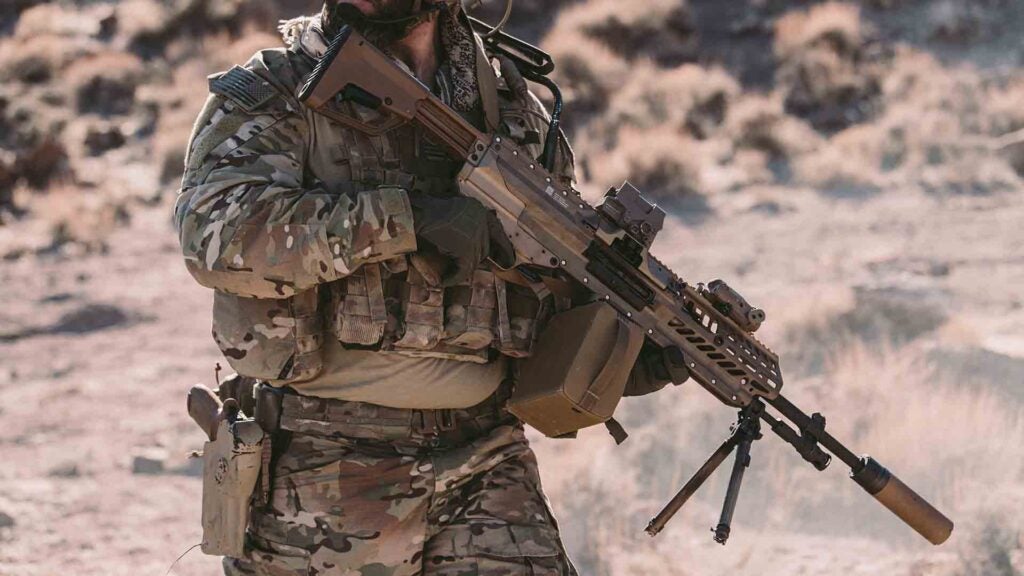Now that the Army has selected the Next Generation Squad weapon rifle and light machine gun variants, it needs loads of 6.8 mm ammunition before it can start putting the weapons into more soldiers’ hands.
The Army ultimately plans to buy 107,000 of what it has dubbed M5 rifles and 13,000 M250 machine guns from Sig Sauer, which was recently awarded a contract worth a total of $4.7 billion to produce the weapons as well as all the 6.8 mm ammunition for the next several years, Army officials told reporters on Wednesday. The Army officials could not say how long it will take to field all the weapons to soldiers.
“The fielding of the weapon is based upon ammunition production,” Army Brig. Gen. Larry Burris said at a Pentagon news conference. “What we don’t want to do is field capability to a unit where we don’t have training ammunition or contingency ammunition if required.”
Subscribe to Task & Purpose Today. Get the latest in military news, entertainment, and gear in your inbox daily.
Retired Army Maj. Gen. Robert Scales told Task & Purpose in January that 6.8 mm rounds fly at a supersonic velocity longer than 5.56 mm rounds, making them more accurate, and they are more controllable on fully automatic fire than 7.62 mm ammunition.
Moreover, the 6.8 mm round is optimal for close combat between 500 and 600 meters, said Scales, who served on the Defense Department’s Close Combat Lethality Task Force that was established by then-Defense Secretary James Mattis.

The first Army unit is expected to receive the Next Generation Squad Weapon rifle and light machine gun variants by September 2023, said Burris, soldier lethality cross-functional team director.
The Next Generation Squad Weapon is intended to replace the M4 carbine and M249 automatic weapons for soldiers who serve in frontline military occupational specialties. The rest of the Army will continue to use the M4 and M249, which chamber 5.56 mm rounds, as well as the M240 machine gun, which chambers 7.62 mm rounds.
Following a 2017 study into small arms ammunition, the Army decided that the Next Generation Squad Weapon needed to fire a 6.8 mm round to penetrate enemy body armor. Gen. Mark Milley, then Army chief of staff, told Congress in May 2017 that body armor as cheap as $250 could stop the 5.56 mm rounds fired by the M4 and M249.
Burris declined to say on Wednesday if the 6.8 mm round could penetrate Level IV armor plates, the highest rifle plating under National Institute for Justice body armor standards.
“I can’t get into specifics of what capability it provides, but it does provide greater energy against protected and non-protected targets at various ranges,” Burris said. “I can’t really go into the rest of it. It’s a much greater capability.”
The Army has no plans to reduce its production of both 5.56 mm and 7.62 mm ammunition, said Brig. Gen. William M. Boruff, joint program executive officer for armaments and ammunition.
Equipping soldiers with enough 6.8 mm ammunition will be a “key challenge for my office and the Army,” said Boruff, who noted the Army has not introduced a new caliber for ammunition in 65 years.
Soldiers currently don’t have to be concerned about having enough 5.56 mm ammunition for their M4 carbines and M249 Squad Automatic Weapons because the Army has spent decades refining its processes to ensure it has enough ammunition and the defense industry is able to meet the Army’s needs, Boruff said.
“Now, consider preparing a new weapon fielding starting with absolutely zero inventory and the industrial base being established,” Boruff said. “It’s daunting – daunting indeed.”
Sig Sauer will initially provide the Next Generation Squad Weapon’s 6.8 mm ammunition while the Army builds a new facility at the Lake City Army Ammunition Plant in Independence, Missouri, to produce the ammunition, he said. That facility is expected to open around 2026, after which the Army will start taking the lead role in producing the 6.8 mm rounds while Sig Sauer will become a backup source.
“When it’s time for them to field in 2023, 2024, we will have enough reserve ammunition for the units to go forward with the fielding,” Boruff said. “There’s going to be no delay in the fielding plan right now on the ammunition side.”
Separately, Army officials are also making sure that both variants of the Next Generation Squad Weapon are compatible with the Integrated Visual Augmentation System, the service’s advanced night-vision optics that are still under development, said Col. Scott Madore, project manager, soldier lethality.
“There’s a lot more to do,” Madore said. “Integration is definitely something that is of high priority at PEO Soldier to make sure a soldier’s kit functions properly together,” Madore said.
What’s new on Task & Purpose
Want to write for Task & Purpose? Click here. Or check out the latest stories on our homepage.
